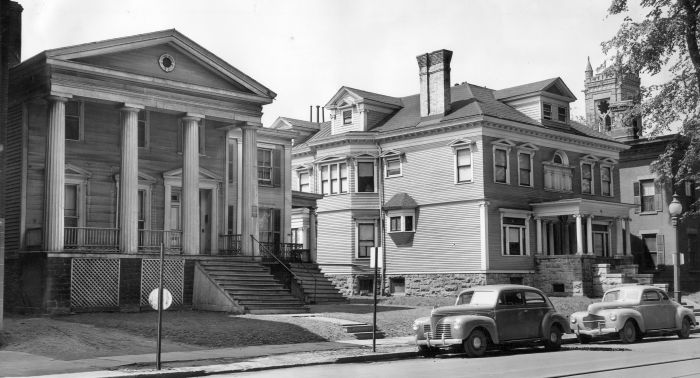|
SYRACUSE HERALD-AMERICAN Changes along Fayette Park Century Old House to Be Razed
Sunday, June 9, 1946 By David Wallace Two old houses that have stood close together for half a century on the south side of Fayette Park are about to be separated. The elder, at 526 E. Genesee St., a good example in the days when it was built of the Greek revival style in architecture, is more than 100 years old. It has been used as a rooming house in recent years, but has been sold to the Syracuse Boys Club adjoining it on the other side, and will be demolished soon to make room for a playground. The other house, numbered 418, will remain as a headquarters for lodges of the Independent Order of Odd Fellows in Syracuse. Histories of these two sites have been intertwined so that they really belong together. Although the younger house has been there only since 1895, it replaced a structure with associations of names long ago prominent in this city. Homes there belong to a period when Fayette Park was first put in. It was the donation of citizens to afford a breathing spot, where originally the Genesee turnpike had cut through on an angle. Moses D. Burnet, acting as trustee for the Syracuse Company, deeded these sites on the fringe of the park to Thomas Treadwell Davis, another important figure in real estate transactions. That was in 1838, and likelihood is that Mr. Davis put up two houses, including the one that still stands at 426. Time, the Wheaton Block was the handsomest and most imposing structure in the city. Besides store and office space, it had an auditorium seating 1,200 people, and when Wheaton sold out to Dr. Wieting he got $112,000 for it. That building burned in 1856, and was replaced by the Wieting Block, with the Opera House. Mr. Wheaton was a member of the Board of Education here in 1851-1852, and he and his wife had a reputation for philanthropy. Legends say that they helped in the rescue of runaway slaves. Mrs. Wheaton died in 1858, leaving 11 children. In 1861, Wheaton moved to Northfield, Minn., where he became editor of the Northfield Journal, holding that position until he died in 1880. Out in Minnesota he married Mrs. Sarah Waggoner and they had five children. During the period he owned a house on Fayette Park, it must have been considered to have real value, because after he had mortgaged it, according to the records, there were numbers of liens filed against it through Supreme Court judgments. Besides individuals such as Horace White and Patrick Lynch, various banks, both locally and in Auburn, Binghamton and Cayuga County, held liens. Charles Andrews, acting as receiver for Chares A. Wheaton and others, is noted as having a lien for $21,507.17. Apparently these maters were all settled, as William W. Newell took over the property in 1859, and then it passed through various hands until James M. Ellis bought it in 1867. Succeeding Owners were descendants, Clara Ellis Beach and Lucy C. Balch. Then Dr. Henry L. Eisner bought the property in 1895 for $15,000. He built a new home then spending $50,000 on it, according to news accounts of the period a mansion people talked about, especially the model office suite with laboratory and operating rooms. He and Dr. Curtin were both connected with the Medical College of Syracuse University. Dr. Curtin bought the house in 1916, after Dr. Elsner died, and used it for his own practice, as well as home, until he, in turn, died. For a brief period it was an apartment house, and then Mrs. Curtin sold it last year to the Odd Fellows Temple Association. Mr. and Mrs. Nelson Hill, who had been renting apartments, remained as caretakers, and while the building has been changed somewhat for club purposes, the fine old woodwork of mahogany, oak and maple remains. |
